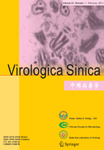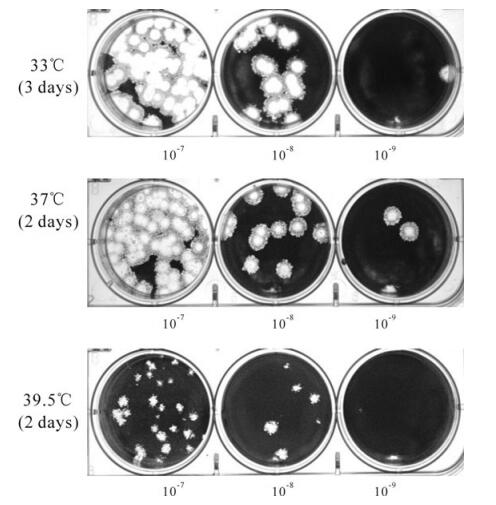-
Ahola T, Laakkonen P, Vihinen H, et al. 1997. Critical residues of Semliki Forest Virus RNA capping enzyme involved in methyltransferase and guanylyltransferase-like activities. J Virol, 71: 392-397.
-
Almazan F, Dediego M L, Galán C, et al. 2006. Construction of a severe acute respiratory syndrome coronavirus infectious cDNA clone and a replicon to study coronavirus RNA synthesis. J Virol, 80: 10900-10906.
doi: 10.1128/JVI.00385-06
-
Benarroch D, Selisko B, Locatelli G A, et al. 2004. The RNA helicase, nucleotide 5'-triphosphatase and RNA 5'-triphosphatase activities of Dengue virus protein NS3 are Mg2+dependent and require a functional Walker B motif in the helicase catalytic core. Virology, 328: 208-218.
doi: 10.1016/j.virol.2004.07.004
-
Brian D A, Baric R S. 2005. Coronavirus genome structure and replication. Curr Top Microbiol Immunol, 287: 1-30.
-
Brockway S M, Denison M R. 2005. Mutagenesis of the murine hepatitis virus nsp1-coding region identifies residues important for protein processing, viral RNA synthesis, and viral replication. Virology, 340: 209-223.
doi: 10.1016/j.virol.2005.06.035
-
Bujnicki J M, Rychlewski L. 2002. In silico identification, structure prediction and phylogenetic analysis of the 2'-O-ribose (cap 1) methyltransferase domain in the large structural protein of ssRNA negative-strand viruses. Protein Eng, 15: 101-108.
doi: 10.1093/protein/15.2.101
-
Casais R, Thiel V, Siddell S G, et al. 2001. Reverse genetics system for the avian coronavirus infectious bronchitis virus. J Virol, 75: 12359-12369.
doi: 10.1128/JVI.75.24.12359-12369.2001
-
Coley S E, Lavi E, Sawicki S G, et al. 2005. Recombinant mouse hepatitis virus strain A59 from cloned, full-length cDNA replicates to high titers in vitro and is fully pathogenic in vivo. J Virol, 79: 3097-3106.
doi: 10.1128/JVI.79.5.3097-3106.2005
-
Decroly E, Imbert I, Coutard B, et al. 2008. Coronavirus nonstructural protein 16 is a cap-0 binding enzyme possessing (Nucleoside-2'O)-methyltransferase activity. J Virol, 82: 8071-8084.
doi: 10.1128/JVI.00407-08
-
Drosten C, Gunther S, Preiser W, et al. 2003. Identification of a novel coronavirus in patients with severe acute respiratory syndrome. N Engl J Med, 348: 1967-1976.
doi: 10.1056/NEJMoa030747
-
Eckerle L D, Lu X, Sperry S M, L, et al. 2007. High fidelity of murine hepatitis virus replication is decreased in nsp14 exoribonuclease mutants. J Virol, 81: 12135-12144.
doi: 10.1128/JVI.01296-07
-
Egloff M P, Benarroch D, Selisko B, et al. 2002. An RNA cap (nucleoside-2'O-)-methyltransferase in the flavivirus RNA polymerase NS5: crystal structure and functional characterization. EMBO J, 21: 2757-2768.
doi: 10.1093/emboj/21.11.2757
-
Egloff M P, Decroly E, Malet H, et al. 2007. Structural and functional analysis of methylation and 5' RNA sequence requirements of short capped RNAs by the methyltransferase domain of dengue virus NS5. J Mol Biol, 372: 723-736.
doi: 10.1016/j.jmb.2007.07.005
-
Egloff M P, Ferron F, Campanacci V, et al. 2004. The severe acute respiratory syndrome-coronavirus replicative protein nsp9 is a single-stranded RNA-binding subunit unique in the RNA virus world. Proc Natl Acad Sci USA, 101: 3792-3796.
doi: 10.1073/pnas.0307877101
-
Enjuanes L, Sola I, Alonso S, et al. 2005. Coronavirus reverse genetics and development of vectors for gene expression. Curr Top Microbiol Immunol, 287: 161-197.
-
Ginalski K, Godzi k A, Rychlewski L. 2006. Novel SARS unique AdoMet-dependent methyltransferase. Cell Cycle, 5: 2414-2416.
doi: 10.4161/cc.5.20.3361
-
Guarino L A, Bhardwaj K, Dong W, et al. 2005. Mutational analysis of the SARS virus Nsp15 endoribonuclease, identification of residues affecting hexamer formation. J Mol Biol, 353: 106-1117.
-
Harcourt B H, Jukneliene D, Kanjanahaluethai A, et al. 2004. Identification of severe acute respiratory syndrome coronavirus replicase products and characterization of papain-like protease activity. J Virol, 78: 13600-13612.
doi: 10.1128/JVI.78.24.13600-13612.2004
-
Ivanov K A, Ziebuhr J. 2004. Human coronavirus 229E nonstructural protein 13, characterization of duplex-unwinding, nucleoside triphosphatase, and RNA 5'-triphosphatase activities. J Virol, 78: 7833-7838.
doi: 10.1128/JVI.78.14.7833-7838.2004
-
Roth-Cross J K, Stokes H, Chang G, et al. 2009. Organ specific attenuation of Murine Hepatitis Virus Strain A59 by replacement of catalytic residues in the putative viral cyclic phosphodiesterase ns2. J Virol, 83: 3743-53.
doi: 10.1128/JVI.02203-08
-
Kozbial P Z, Mushegian A R. 2005. Natural history of S-adenosylmethionine-binding proteins. BMC Struct Biol, 5: 19.
doi: 10.1186/1472-6807-5-19
-
Ksiazek T G, Erdman D, Goldsmith C S, et al. 2003. A novel coronavirus associated with severe acute respiratory syndrome. N Engl J Med, 348: 1953-1966.
doi: 10.1056/NEJMoa030781
-
Martin J L, McMillan F M. 2002. SAM (dependent) Ⅰ AM: the S-adenosylmethionine-dependent methyltransferase fold. Curr Opin Struct Biol, 12: 783-793.
doi: 10.1016/S0959-440X(02)00391-3
-
Masters P S. 2006. The molecular biology of coronaviruses. Adv Virus Res, 66: 193-292.
doi: 10.1016/S0065-3527(06)66005-3
-
Masters P S, Rottier P J M. 2005. Coronavirus reverse genetics by targeted RNA recombination. Curr Top Microbiol Immunol, 287: 133-159.
-
Putics A, Filipowicz W, Hall J, et al. 2005. ADP-ribose-1-monophosphatase, a conserved coronavirus enzyme that is dispensable for viral replication in tissue culture. J Virol, 79: 12721-12731.
doi: 10.1128/JVI.79.20.12721-12731.2005
-
Ray D, Shah A, Tilgner M, et al. 2006. West Nile virus 5'-cap structure is formed by sequential guanine N-7 and ribose 2'-O methylations by nonstructural protein 5. J Virol 80: 8362-8370.
doi: 10.1128/JVI.00814-06
-
Sawicki S G, Sawicki D L, Siddell S G. 2007. A contemporary view of coronavirus transcription. J Virol, 81: 20-29.
doi: 10.1128/JVI.01358-06
-
Sawicki S G, Sawicki D L, Younker D, et al. 2005. Functional and genetic analysis of coronavirus replicase transcriptase proteins. PLoS Pathogens, 1: e39.
doi: 10.1371/journal.ppat.0010039
-
Sawicki D, Wang T, Sawicki S. 2001. The RNA structures engaged in replication and transcription of the A59 strain of mouse hepatitis virus. J Gen Virol, 82: 385-396.
doi: 10.1099/0022-1317-82-2-385
-
Schelle B, Karl N, Ludewig B, et al. 2005. Selective replication of coronavirus genomes that express nucleocapsid protein. J Virol, 79: 6620-6630.
doi: 10.1128/JVI.79.11.6620-6630.2005
-
Siddell S G, Ziebuhr J, Snijder E J. 2005. Coronaviruses, toroviruses, and arteriviruses. In: Virology (Mahy B W J and ter Meulen V ed. ), Hodder Arnold, London, United Kingdom: Topley & Wilson's microbiology and microbial infections. p823-856.
-
Sturman L S, Eastwood C, Frana M F, et al. 1987. Temperature-sensitive mutants of MHV-A59. Adv Exp Med Biol, 218:159-168
doi: 10.1007/978-1-4684-1280-2
-
Thiel V. 2007. Reverse genetic analysis of coronavirus replication. In: Coronaviruses: molecular and cellular biology (Thiel V. ed). Norfolk, United Kingdom: Caister Academic Press, p109-132.
-
Thiel V, Herold J, Schelle B, et al. 2001. Infectious RNA transcribed in vitro from a cDNA copy of the human coronavirus genome. J Gen Virol, 82: 1273-1281.
doi: 10.1099/0022-1317-82-6-1273
-
Thiel V, Siddell S G. 2005. Reverse genetics of coronaviruses using vaccinia virus vectors. Curr Top Microbiol Immunol, 287: 199-227.
-
Von Grotthuss M, Wyrwicz L S, Rychlewski L. 2003. mRNA cap-1-methyltransferase in the SARS genome. Cell, 113: 701-702.
doi: 10.1016/S0092-8674(03)00424-0












